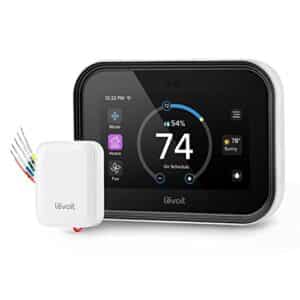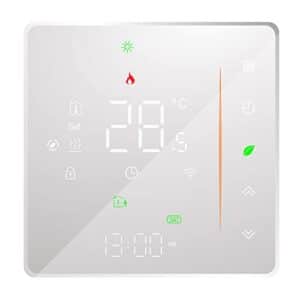How To Install Smart Thermostat?
Key Takeaways
- Installing a smart thermostat can bring precise temperature control, energy efficiency, and convenience to your home.
- Before installation, gather all the necessary tools and materials, review the manufacturer’s instructions, and choose an optimal location for the thermostat.
- To install the smart thermostat, turn off the power, remove the old thermostat, wire the new thermostat according to the instructions, and connect it to Wi-Fi. Seek professional assistance if needed.
Installing a smart thermostat can bring numerous benefits to your home, including precise temperature control, energy efficiency, and convenience. With the right tools and instructions, you can easily install a smart thermostat yourself. In this article, we will provide you with a step-by-step guide on how to install a smart thermostat.
Gather Necessary Tools and Materials
Before you begin the installation process, it’s important to gather all the necessary tools and materials. This includes a screwdriver, wire strippers, a voltage tester, and the smart thermostat itself. Make sure to review the manufacturer’s installation instructions to familiarize yourself with the specific requirements of your smart thermostat.
Choose an Optimal Location
Once you have your tools ready, choose an optimal location for your smart thermostat. It should be placed away from direct sunlight, drafts, and heat sources to ensure accurate temperature readings. Additionally, ensure proper airflow and accessibility for programming and adjustments.
Turn Off Power and Remove Old Thermostat
Before starting the installation, turn off the power to your HVAC system at the circuit breaker. Use a voltage tester to verify that the power is off. Next, remove the cover of the old thermostat, disconnect the wires, and remove the mounting plate.
Wire the New Smart Thermostat
Now it’s time to wire the new smart thermostat according to the manufacturer’s instructions. Connect each labeled wire to its corresponding terminal on the thermostat and secure them in place. Push any excess wiring back into the wall cavity and attach the new thermostat’s mounting plate.
Turn On Power and Connect to Wi-Fi
After wiring the thermostat, turn on the power to your HVAC system. Once the power is restored, connect the thermostat to your home’s Wi-Fi network following the prompts on the thermostat’s interface. Download and install the accompanying smart app on your smartphone or tablet. Follow the on-screen instructions to create an account and set up the smart thermostat.
Considerations for Installation
During the installation process, there are a few additional considerations to keep in mind:
- Ensure that you have a five-wire thermostat cable in place. If you don’t have a C-wire, you have a few options. You can install a new wire, purchase a smart thermostat that doesn’t require a C-wire, or use a C-wire adapter.
- If you’re unsure about the existing thermostat’s electrical specifications or need to install a C-wire, it may be best to call a professional for assistance.
- Handle thermostat wires with caution and avoid touching any line voltage wires.
- Take a picture of the existing thermostat wires before disconnecting them for reference.
Conclusion
Installing a smart thermostat can be a straightforward process if you follow the proper steps and guidelines. By gathering the necessary tools, choosing an optimal location, and wiring the thermostat correctly, you can enjoy the benefits of precise temperature control and energy efficiency in your home. If you encounter any difficulties or are unsure about the installation, it’s always recommended to seek professional assistance.
Related Websites:
FAQs:
Q: What are the benefits of installing a smart thermostat?
Installing a smart thermostat offers several benefits. It allows you to control your home’s temperature remotely, saving energy and reducing utility bills. Smart thermostats also learn your preferences and adjust temperature settings accordingly, providing personalized comfort. Additionally, they can contribute to environmental conservation by optimizing energy usage.
Q: How does a smart thermostat differ from a traditional thermostat?
Unlike traditional thermostats, smart thermostats offer advanced features such as remote control and programming flexibility. They can be controlled using smartphones or voice assistants, allowing you to adjust temperature settings from anywhere. Smart thermostats also adapt to your schedule and can learn from your behavior, optimizing energy usage and providing personalized comfort.
Q: Can a smart thermostat help me save on energy costs?
Yes, a smart thermostat can contribute to significant energy savings. By allowing you to remotely control and program your heating and cooling settings, you can avoid unnecessary energy usage. Smart thermostats also learn your preferences and adjust temperature settings accordingly, optimizing energy consumption. Over time, these energy-saving features can lead to reduced utility bills.
Q: What are some common installation issues and how can I resolve them?
Some common installation issues include compatibility problems, incorrect wiring, and connectivity issues. To resolve these, ensure compatibility between your HVAC system and the smart thermostat before purchase. Follow the manufacturer’s installation guide carefully and double-check the wiring connections. If connectivity issues arise, ensure your Wi-Fi network is stable and follow troubleshooting steps provided by the manufacturer.
Q: Do I need professional assistance for smart thermostat installation?
While installation is generally straightforward, it’s important to assess your own skills and comfort level. If you’re unsure or not experienced with electrical systems, it’s recommended to seek professional assistance to ensure a safe and proper installation. Manufacturers may also provide professional installation services or have certified installers who can help.






